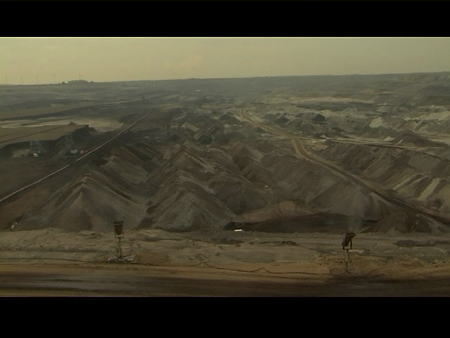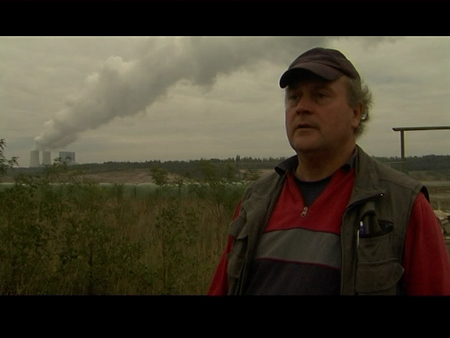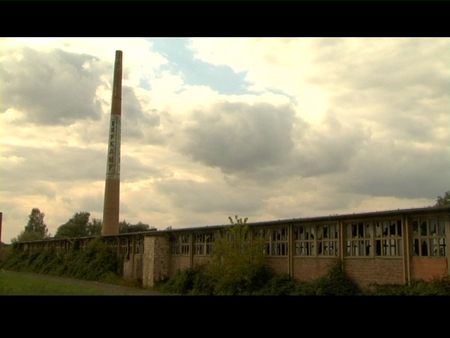Die farbigen Gräber / The Colored Graves (investigative shooting)
Social and economic change in Altenburger Land
DVD 16 min 2009
Camera: Miriam Faßbender
Sound: Roman Schorbach
Editing: Melanie Lischker
Directed by Johannes Kochs
Production: shorefilm
Altenburger Land in eastern Thuringia was once a purely agricultural region, home to some of the most fertile soil in all of Germany. The character of its outlying areas was shaped by sheep farming, and eventually the beginnings of industry, wool weaving mills, built by Leipzig entrepreneurs, started to alter the villages.
In the seventeenth century combustible earth was discovered in the area. Mining on a large scale, however, did not begin until the eighteen-thirties and forties: In 1830 a farmer from Meuselwitz opened the first lignite pit that could be continuously mined. This radically interfered with, and ultimately changed, the agricultural character of the area.
The area transformed into a haven of profit— it is not without reason that coal was called black gold—and smokestacks filled the horizons. The giant forests gave way to coal mining and rail networks. At the turn of the twentieth century the Meuselwitz train station was a major center for the transshipment of goods—it was larger than the remaining thirty-six train stations in the duchy of Saxe-Altenburg combined.
Agriculture was headed for oblivion. The farmers themselves had turned away from it. An industrial proletariat evolved that consisted of immigrants from all over the world, with many hailing from Eastern Europe.
By the end of the nineteen-nineties the production halls that had been built in the nineteenth century the were empty: The machines and workbenches had been ripped from the concrete floors and taken away; the crane systems had likewise been removed.
There were once jobs in this part of Thuringia, many people once worked here—and now nothing of this remains. The land has been dug up, the industrial parks—the symbols of work—have been deserted, and the villages have been excavated into non-existence. After 1990 many factories were closed. Many workers lost their jobs and the future holds little for young people in the area.
What has become of the people who live here? How has life for those living in Altenburger Land evolved and how has the changed situation affected individual lives and livelihoods over the course of time? What is life like in this region today?
Social and economic change in Altenburger Land
DVD 16 min 2009
Camera: Miriam Faßbender
Sound: Roman Schorbach
Editing: Melanie Lischker
Directed by Johannes Kochs
Production: shorefilm
Altenburger Land in eastern Thuringia was once a purely agricultural region, home to some of the most fertile soil in all of Germany. The character of its outlying areas was shaped by sheep farming, and eventually the beginnings of industry, wool weaving mills, built by Leipzig entrepreneurs, started to alter the villages.
In the seventeenth century combustible earth was discovered in the area. Mining on a large scale, however, did not begin until the eighteen-thirties and forties: In 1830 a farmer from Meuselwitz opened the first lignite pit that could be continuously mined. This radically interfered with, and ultimately changed, the agricultural character of the area.
The area transformed into a haven of profit— it is not without reason that coal was called black gold—and smokestacks filled the horizons. The giant forests gave way to coal mining and rail networks. At the turn of the twentieth century the Meuselwitz train station was a major center for the transshipment of goods—it was larger than the remaining thirty-six train stations in the duchy of Saxe-Altenburg combined.
Agriculture was headed for oblivion. The farmers themselves had turned away from it. An industrial proletariat evolved that consisted of immigrants from all over the world, with many hailing from Eastern Europe.
By the end of the nineteen-nineties the production halls that had been built in the nineteenth century the were empty: The machines and workbenches had been ripped from the concrete floors and taken away; the crane systems had likewise been removed.
There were once jobs in this part of Thuringia, many people once worked here—and now nothing of this remains. The land has been dug up, the industrial parks—the symbols of work—have been deserted, and the villages have been excavated into non-existence. After 1990 many factories were closed. Many workers lost their jobs and the future holds little for young people in the area.
What has become of the people who live here? How has life for those living in Altenburger Land evolved and how has the changed situation affected individual lives and livelihoods over the course of time? What is life like in this region today?



